
About 800 years ago, the ancestors of the Inuvialuit came to the Mackenzie River Delta (Northwest Territories, Canada), and beluga whales took a central place in their economy and culture. This is evidenced by the presence of numerous bones of these cetaceans in archaeological excavations in the Mackenzie Delta. The Inuvialuit have been hunting beluga whales for seven centuries and to this day, but little is known about its impact on the beluga population.
Using paleogenome and stable isotope analysis of beluga whale zooarchaeological remains and comparing these data with modern beluga tissue samples, an international team of researchers from various fields led by archaeologist Max Friesen (University of Toronto) and paleogeneticist Elaine Lorentzen (University of Copenhagen) and including scientists from the Institute of Ecology and Evolution RAS, investigated the impact of 700 years of fishery on its sustainability, genetic diversity of beluga whales, their population structure and trophic ecology.
Analysis of beluga whale bones from archaeological collections in the Mackenzie Delta revealed no changes in population genetic diversity over time, suggesting population continuity and little impact of Inuvialuit harvesting on the genetic diversity of modern beluga whales. Genomic analysis used to determine the sex of beluga whales revealed marked shifts in the ratio of females to males harvested at different times, which may be related to changes in past Inuvialuit resource use of the species, and isotopic analysis revealed simultaneous shifts in the trophic ecology of female and male beluga whales, which may have been influenced by ongoing changes in beluga whale behavior and marine ecosystems.

This study is an example of combining genomic sexing and isotopic analysis of zooarchaeological remains to advance our understanding of hunting practices and the historical ecology of animals.
Skovrind M., Louis M., Ferguson S.H., Glazov D.M., Litovka D.I., Loseto L., Meschersky I.G., Miller M.M., Petr M., Postma L., Rozhnov V.V., Scott M., Westbury M.V., Szpak P., Friesen T.M., Lorenzen E.D. Elucidating the sustainability of 700 years of Inuvialuit beluga whale hunting in the Mackenzie River Delta, Northwest Territories, Canada // PNAS. 2024. V. 121. No. 34. e2405993121. https://doi.org/10.1073/pnas.2405993121
